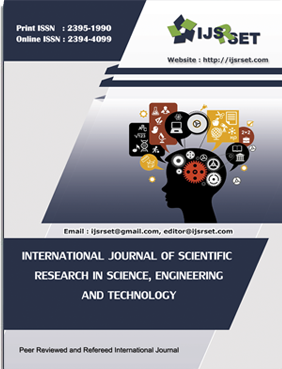Navigation Aid for Visually Impaired Persons using Vibration Haptics on a Jacket-cum-Headband Setup
DOI:
https://doi.org/10.32628/IJSRSET2411434Keywords:
Navigation Aid, Raspberry Pi, CNN Algorithm, Object Detection, Visually ImpairedAbstract
The device proposed here is a jacket-cum-headband device for mapping chaotic environments and communicating locations of obstacles to visually impaired persons. This project focuses on constructing a device which uses vibration as a haptic mode of communication to inform users on potential obstacles in their vicinity. This device is a low-cost solution for visually impaired persons to navigate within chaotic indoor environments such as houses, schools, or workplaces. The device is manufactured using 3D printed parts and readily available electronics, mounted onto articles of clothing for ease of use. The device is equipped with a Raspberry Pi 4B microcontroller, a USB colour camera, and 3 vibration-haptic modules embedded within a wearable shirt. The device uses Convolution Neural Networks (CNNs) and mathematical estimation formulas to detect obstacles in the user’s proximity and determine their distance and direction from the user. The device communicates the locations of potentially hazardous obstacles to the user by inducing vibrations of varied intensity in the vibration-haptic modules. The device is tested on 4 different objects located in front of, to the left of, and to the right of the user, at distances between 1 metre and 6 metre.
📊 Article Downloads
References
P. Vashist et al., “Blindness and visual impairment and their causes in India: Results of a nationally representative survey,” 2022, Accessed: Oct. 02, 2024. [Online]. Available: https://doi.org/10.1371/journal.pone.0271736 DOI: https://doi.org/10.1371/journal.pone.0271736
K. Gopal, S. Kumar, and O. Garg, “Senior care reforms in India: Reimagining the Senior care paradigm.,” 2023. Accessed: Oct. 02, 2024. [Online]. Available: https://doi.org/10.31219/osf.io/tnr98 DOI: https://doi.org/10.31219/osf.io/tnr98
W. Jeamwatthanachai, M. Wald, and G. Wills, “Indoor navigation by blind people: Behaviors and challenges in unfamiliar spaces and buildings,” British Journal of Visual Impairment, vol. 37, no. 2, pp. 140–153, May 2019, doi: 10.1177/0264619619833723. DOI: https://doi.org/10.1177/0264619619833723
V. Kunta, C. Tuniki, and U. Sairam, Multi-Functional Blind Stick for Visually Impaired People. IEEE, 2020. DOI: https://doi.org/10.1109/ICCES48766.2020.9137870
M. H. Abidi, A. Noor Siddiquee, H. Alkhalefah, and V. Srivastava, “A comprehensive review of navigation systems for visually impaired individuals,” Jun. 15, 2024, Elsevier Ltd. doi: 10.1016/j.heliyon.2024.e31825. DOI: https://doi.org/10.1016/j.heliyon.2024.e31825
F. Barontini, M. G. Catalano, L. Pallottino, B. Leporini, and M. Bianchi, “Integrating Wearable Haptics and Obstacle Avoidance for the Visually Impaired in Indoor Navigation: A User-Centered Approach,” IEEE Trans Haptics, vol. 14, no. 1, pp. 109–122, Jan. 2021, doi: 10.1109/TOH.2020.2996748. DOI: https://doi.org/10.1109/TOH.2020.2996748
S. Khusro, B. Shah, I. Khan, and S. Rahman, “Haptic Feedback to Assist Blind People in Indoor Environment Using Vibration Patterns,” Sensors, vol. 22, no. 1, Jan. 2022, doi: 10.3390/s22010361. DOI: https://doi.org/10.3390/s22010361
S. Dong, J. Gallagher, A. Jackson, and M. Levesley, “A Hand-Held Device Presenting Haptic Directional Cues for the Visually Impaired,” Sensors (Basel), vol. 23, no. 20, Oct. 2023, doi: 10.3390/s23208415. DOI: https://doi.org/10.3390/s23208415
Downloads
Published
Issue
Section
License
Copyright (c) 2024 International Journal of Scientific Research in Science, Engineering and Technology

This work is licensed under a Creative Commons Attribution 4.0 International License.




